Columnar apple varieties for Siberia
The best columnar apple trees for Siberia are winter-hardy varieties that delight with the first harvest already in the second year after planting.
- The best varieties for Siberia
- West
- East
- Landing features
- Selection of seedlings
- Location and timing
- Landing technology
- Care requirements
- Watering
- Mulching and loosening
- Fertilizer
- Pruning and shaping
- Preparation for wintering
- Diseases and pests
- Scab
- Aphid
- Medianitsa (leaf flies)
- Apple flower beetle
- Moth
- Gardeners reviews

Columnar apple varieties for Siberia
The best varieties for Siberia
Columnar apple trees are early-growing crops that form one trunk without branches and do not take up much space in the garden. Thanks to these qualities, gardeners give preference to this particular group.
The climatic conditions in Siberia are different, therefore, a zoned variety should be selected.
West
For Western Siberia, semi-dwarf varieties are suitable, the height of which does not exceed 2 m. These include:
- The president;
- Nectar;
- Baby;
- Ostankino.
Apple trees with this name grow successfully and give a good harvest - fruiting occurs in the last decade of August or early September.
The root system is dense, compact, easily tolerates the transplant procedure. The fruits are large - they weigh about 200 g, in the President, Malyukha and Ostankino varieties they are sweetish-sour, in the Medoc hybrid form they are sweet without sourness.
East
For Eastern Siberia, breeders have bred the following varieties of columnar apples:
- Vasyugan;
- Iksha;
- KV-40;
- Barguzin;
- Moscow Necklace.
They are highly frost-resistant - they successfully tolerate temperatures as low as -40 °, provided they are well cared for and properly covered.
Plant height varies from 2.5 to 3 m. Fruits of medium size - 120-150 g, all varieties are sweet with a slight sourness.
Landing features
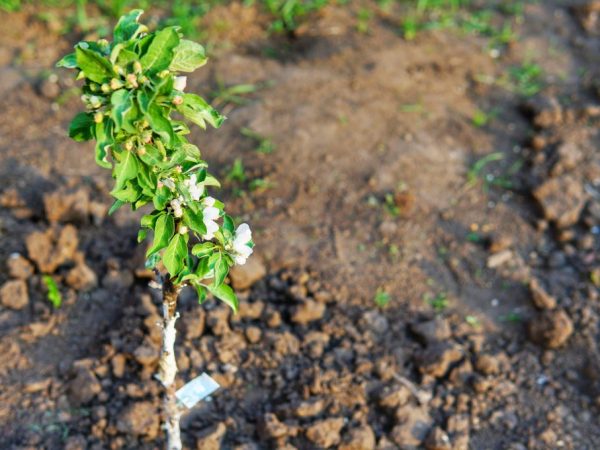
Only healthy seedlings are suitable for planting.
Taking into account the peculiarity of the climatic conditions of Siberia, when planting trees, certain requirements must be strictly observed in order to get a healthy, and most importantly, a fruitful apple orchard.
Selection of seedlings
It is important not only to familiarize yourself with the description of Siberian varieties, but also to choose the right planting material. The further health and fruiting of the tree will depend on its quality.
For planting in this area, annual seedlings are best suited - they take root faster and better in a new place.
It is recommended to buy planting material in horticultural nurseries or specialized stores.
When choosing a planting material, several important criteria must be taken into account:
- Each copy must contain a tag indicating the age and rootstock of the seedling.
- When buying, it is important to pay attention to the condition of the root system. Better to give preference to trees with a closed root system. They are planted by the method of transshipment of an earthen coma without the risk of injury to the roots. For apple trees with an open underground part, the roots must be intact, without signs of mold, cracks, cracks and at least 40 cm long.Seedlings with an open root system, immediately after purchase, must be placed in a moist environment - moistened soil or water, in order to eliminate the risk of roots drying out before planting in the ground.
- Choose specimens that do not contain lateral stems. There should be several healthy buds on the trunk. The bark of the central conductor, at least 60 cm high, should be free of cracks, breaks and mold.
Location and timing
Given that all varieties of columnar apple trees have a weakly branched root system, they should be planted on fertile soil with good moisture and air permeability. When planting in heavy soils, ensure good drainage. Saplings should be planted in a sunny location protected from winds that dry out the earth.
In the harsh climatic zone, gardeners prefer spring planting, in which plants have a lot of time to adapt before the onset of autumn frosts. When planting in autumn, there is a high risk of freezing of vegetative and flower buds.
Therefore, the preparation of the garden is carried out in the fall. A bucket of compost or humus, 1 kg of wood ash, 50 g of superphosphate and 40 g of potassium salt are added per m². Then a deep digging and leveling is performed.
Landing technology
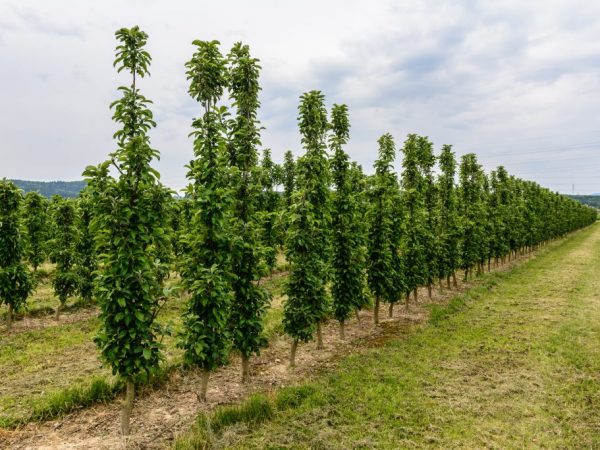
Planting apple trees can be done in rows
Due to the compactness of the crown, columnar apple trees are planted at a distance of 40 cm from each other with a distance in a row of at least 1 m.
Landing is carried out in pre-prepared landing pits. Their dimensions should correspond to the size of the root system or earthen coma (for seedlings with closed roots). A stake made of wood or metal is driven in the center - it will serve as a support and protection against breaking the stem by winds.
First, the pit is spilled with 2-3 buckets of settled water, then the garden soil is poured with a mound and the roots are laid on top, leveled, sprinkled with earth and trampled down well. When planting, it is important that the root collar of the plant remains on the surface of the soil, since when immersed in the ground, it can quickly rot and the tree will die.
The plant is tied to a stake, several holes are pulled out in the area of the trunk circle, through them I moisten the root system - 3-4 buckets of water are consumed per copy. After watering, the soil is mulched with peat, humus or garden soil.
Care requirements
Their further growth, immunity and the quality of fruiting will depend on how correctly and on time the trees are cared for.
Watering
Watering plays an important role in cultivation. It is produced throughout the growing season. The juiciness and taste of the future harvest will depend on the frequency and amount of moisture introduced.
The first moistening is carried out in the spring - during the period of sap flow, then before flowering and two weeks after it.
The trees experience the greatest need for moisture during the period of fruit pouring, therefore, the amount of water introduced is doubled. The last water-charging irrigation is carried out in the fall - a month before the onset of the first frost.
For a young plant 1-3 years old, 3-4 buckets of water are consumed, 10 buckets of water are added under adult fruit-bearing trees.
Mulching and loosening
After watering, the soil must be loosened, weeds are removed, then mulched with humus, peat or garden soil. Mulch prevents the soil from drying out, and loosening increases its aeration.
Fertilizer
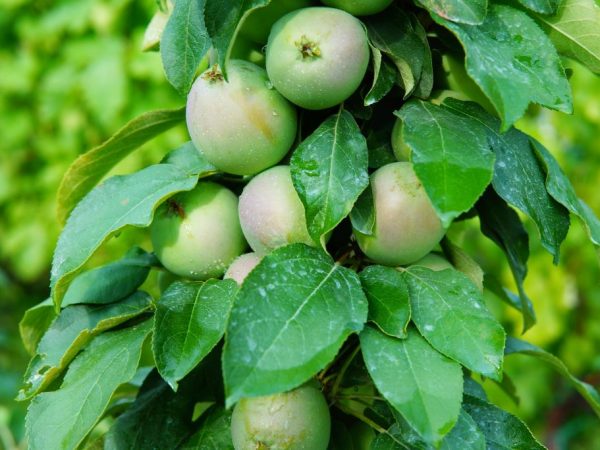
The tree must be fertilized
Top dressing is one of the important conditions for the successful cultivation of columnar apple trees. With the onset of stable spring heat, when the buds begin to awaken on the trees, they are fed with a urea solution (50 g of the substance is dissolved in a bucket of water). Liquid fertilizer is applied at the root.
With an interval of 15 days, the second and third feeding of trees with a urea solution is carried out. During flowering and fruit pouring, apple trees can be fed with superphosphate (50 g) and potassium salt (40 g). This amount is calculated for 10 liters of water.
Pruning and shaping
Cultivation of columnar apple trees in Siberia involves regular pruning - in spring and autumn. The essence of the procedure is to remove all shoots damaged by diseases, winds and frosts. Spring dooming is carried out before the start of sap flow, autumn - after leaf fall.
The tree does not need shaping, since it does not have a young growth. In case of appearance, the side stalks are removed to the ring, and the places of the cuts are sprayed with copper sulfate and covered with garden var.
Preparation for wintering
In the conditions of severe winters, the apical shoot on the central conductor often freezes in this variety. Therefore, before the onset of the first frost, the trees are carefully prepared for winter:
- the trunk of the tree is first wrapped with a material that repels rodents;
- then wrapped in a net to protect from hares;
- at the end, cover with any covering material to the very top.
After snow falls, the near-trunk zone is covered with snow and compacted. During this manipulation, it is important not to damage the delicate roots of the plant, which are close to the surface of the soil.
In such a shelter, trees will not freeze in winter and will be well protected from various rodents.
Diseases and pests
Columnar apple varieties are often affected by various diseases and pests due to improper care and cultivation.
Scab
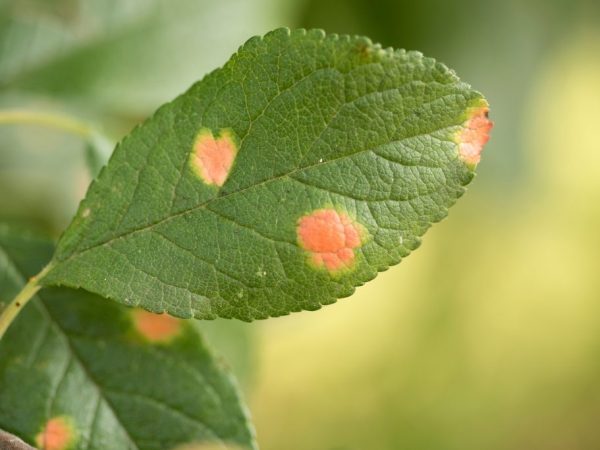
The disease affects the whole tree
This disease damages all plant organs - buds, leaves, fruits, which negatively affects the quality and quantity of the crop. The peak of the development of the disease occurs during the period of blooming of vegetative buds. Trees growing in neglected areas and in conditions of high humidity are most susceptible.
For prevention, trees are treated with Bordeaux liquid (3%). During the budding period, the crown is sprayed with a scorch preparation (one ampoule is used for 10 liters of water).
Immediately after flowering, the crown is irrigated with a solution of Rubigan - 3 g per 10 liters of water.
With the onset of autumn, the site is removed from the fallen leaves, the remains of vegetation and the soil are sprayed with a solution of urea (650 g of the substance is consumed per bucket of water). The second option is ammonium nitrate (800 g per 10 liters of water).
Aphid
This rapidly multiplying insect appears early in the growing season. Aphids feed on the juice of young foliage, shoots, inflorescences. The affected parts are bent, curled, and yellow. Apple trees affected by aphids slow down their growth, bloom and bear fruit poorly.
To prevent the appearance of the parasite before flowering, the crown is treated with kinmix - 2 ml of the substance are consumed per 10 liters of water. Three weeks later, repeated treatment with Inta-Vir (1 tablet per 10 liters of water) is carried out.
At the initial stage of the lesion, you can do without chemistry, using folk remedies - a soap-ash solution, infusion of tobacco, garlic, onion or hot pepper.
Medianitsa (leaf flies)
This parasite appears during the blooming of vegetative buds. A small salad-colored insect sucks juices from all plant organs - flowers, leaves, ovaries and young shoots. The affected areas are covered with a sticky mass. At an advanced stage of infection, the quality and quantity of the crop is significantly reduced.
During the budding period, when the larvae of the parasite appear, the crown and the near-stem zone are treated with ash-soap or tobacco infusion.
If folk remedies did not help, you can use pesticides:
- mitak - 30 ml;
- face - 5 g;
- sumi-alpha - 5 g.
This amount of substances is calculated for 10 liters of water.
Apple flower beetle
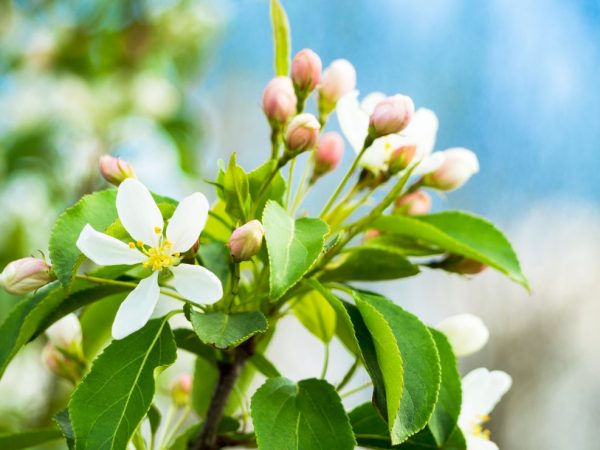
Wood processing will save the harvest
The weevil beetle or apple blossom beetle is a dangerous insect that can destroy all inflorescences on a tree in a season. The parasite appears at the beginning of the growing season. First, it feeds on the juice of the buds, then eats up the contents of the blossoming buds.
The first therapeutic measure is carried out in the budding phase - the crown is treated with fufanon (10 ml of the substance is used per bucket of water). At the stage of blooming flower buds, re-treatment with the drug Inta-Ts-M is carried out - 1 tablet is dissolved in 10 liters of water.
During the formation of fruit ovaries, insects can be collected manually - the near-stem zone is covered with a blanket early in the morning, beetles are shaken off on it, then collected and burned.
Moth
This parasite damages the fruits of the apple tree by gnawing them from the inside. One caterpillar of a moth moth can spoil 3-4 fruits. In case of severe damage, insects can destroy about 50% of the crop.
As a preventive measure, it is recommended to keep the site clean - remove weeds in time, remove fallen leaves and rotten scattered fruits, shoots, and also carry out regular digging of the garden.
For preventive and therapeutic measures, several effective agents are used - mitak (30 g), intavir (1 tablet), kinmix (2.5 ml), biorin (10 ml) or zeta (1 tablet). The dosage is calculated for 10 liters of water. Two weeks after the first treatment, re-spraying with the same means is carried out.
The third preventive treatment is allowed, but necessarily 1.5 months before the planned harvest.
Gardeners reviews
There are several types of columnar apple trees for Siberia. Gardeners note that these varieties grow and bear fruit successfully in this harsh climatic zone.
But for this, the trees are recommended to provide good care and pay due attention, only in this way it will actively develop, grow healthy and thank you with a delicious harvest.

